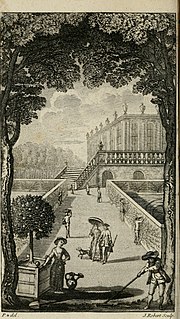 W
WThe Remarkable Gardens of France is intended to be a list and description, by region, of the more than three hundred gardens classified as "Jardins remarquables" by the Ministry of Culture and the Comité des Parcs et Jardins de France.
 W
WThe Domaine de Baudouvin is an estate, garden and public park in the Commune of La Valette-du-Var, just east of Toulon, in the Var Departement of France. Formerly owned by the banker Henri de Rothschild and then residence of the prefect maritime of the Var, it became a public park in 1986. It features the trees, flowers and plants of Provence, the Mediterranean and the tropics, and includes a grand alley of plane trees, a giant bougainvillia, spring-fed fountains and basins, orchards, kitchen gardens and vineyards, a solar-powered "orchard" cooled by mist, and a view of the mountains of the Var. It is classified by the French Ministry of Culture as one of the Remarkable Gardens of France.
 W
WThe Folie St. James was a French landscape garden created between 1777 and 1780 in the Paris suburb of Neuilly-sur-Seine by Claude Baudard de Saint James, the treasurer of the French Navy under Louis XV of France. It was the work of landscape architect François-Joseph Bélanger, who had designed the garden of the Bagatelle for the Comte d'Artois. Saint James instructed Bélanger: "make what you want as long as it's expensive."
 W
WThe Fondation Claude Monet is a nonprofit organisation that runs and preserves the house and gardens of Claude Monet in Giverny, France, where Monet lived and painted for 43 years. Monet was inspired by his gardens, and spent years transforming them, planting thousands of flowers. He believed that it was important to surround himself with nature and paint outdoors. He created many paintings of his house and gardens, especially of water lilies in the pond, the Japanese bridge, and a weeping willow tree.
 W
WThe French formal garden, also called the jardin à la française, is a style of garden based on symmetry and the principle of imposing order on nature. Its epitome is generally considered to be the Gardens of Versailles designed during the 17th century by the landscape architect André Le Nôtre for Louis XIV and widely copied by other European courts. Power in its connection to the French formal garden went beyond imposing it upon nature. Gardens like Versailles were symbols of political, monarchal power ,with one quote stating, The palace was built to impress. "Versailles is a mirage, a sumptuous and theatrical entertainment. It is also a manifestation of glory and power imposed to a great extent by art, luxury, and magnificence." This "manifestation of glory and power" The idea that art and culture can convey power, status, or influence is known as "soft power", or the kind of international influence that is leveraged through tools like culture and art.
 W
WThe French landscape garden is a style of garden inspired by idealized romantic landscapes and the paintings of Hubert Robert, Claude Lorrain and Nicolas Poussin, European ideas about Chinese gardens, and the philosophy of Jean-Jacques Rousseau. The style originated in England as the English landscape garden in the early 18th century, and spread to France where, in the late 18th and early 19th century, it gradually replaced the symmetrical French formal garden.
 W
WWriting about gardens takes a variety of literary forms, ranging from instructional manuals on horticulture and garden design, to essays on gardening, to novels. Garden writing has been published in English since at least the 16th century.
 W
WGardens of the French Renaissance were initially inspired by the Italian Renaissance garden, which evolved later into the grander and more formal jardin à la française during the reign of Louis XIV, by the middle of the 17th century.
 W
WThe Parc Jean-Jacques-Rousseau is a French landscape garden at Ermenonville, in the Département of Oise. It is named for the philosopher Jean-Jacques Rousseau, who stayed there the last six weeks of his life. He died there in 1778 and was buried in an island in the park. The western part, called "le Désert" is managed by the Institut de France, and the northern part by a hotel/restaurant at the Château d'Ermenonville. The other parts are not open to the public, for various reasons.
 W
WThe Keep of Pons is an 830-year-old fortified tower located in Pons, France and is one of the few remnants of the original castle of Pons. The keep is located near the chapel and porch of Saint Gilles and remains of the ramparts. On a hill and visible from a distance, this 33-meter-high (108 ft) edifice is used as the symbol of the city.